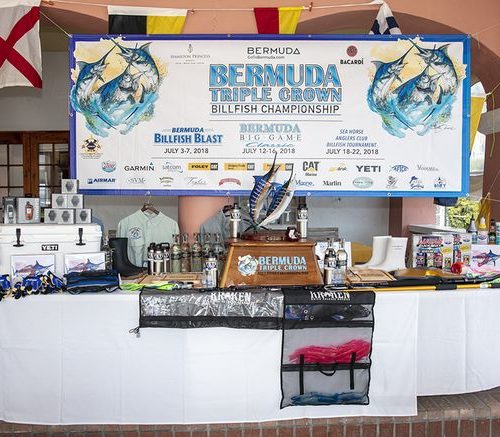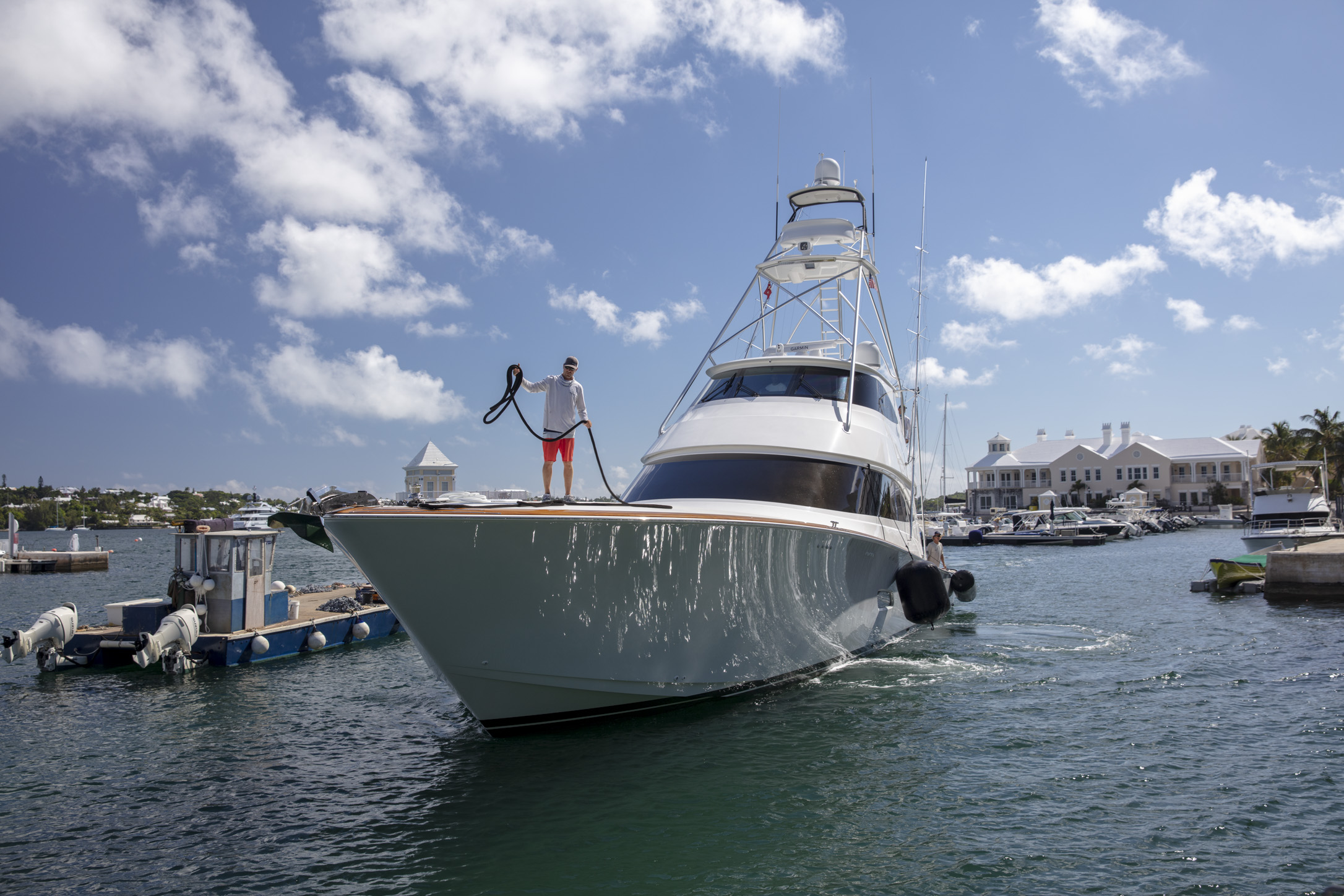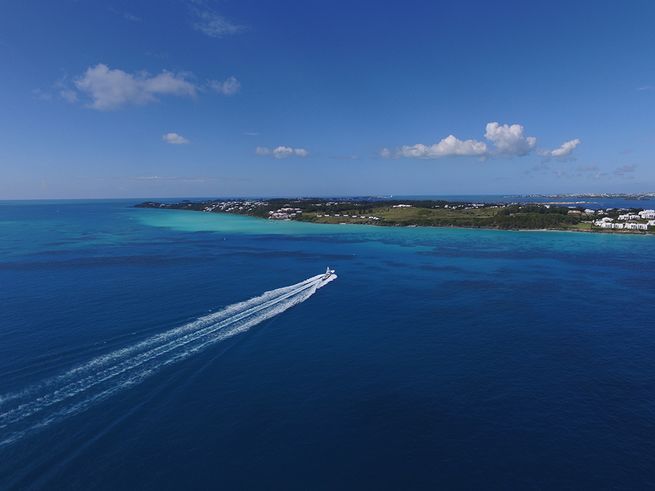
Tips for catching white marlin in Bermuda's offshore waters.
Sport Fish of a Different Color

1 of 5
In 2017, Team Fa La Me took home the Bermuda Triple Crown, scoring an impressive 6,500 points, catching nine blue marlin and 10 white marlin. Second-place winner Legasea caught just three white marlin, and third-place finisher Galatea released none. Although white marlin (200 points each) are worth fewer than half the points of blues (500), Fa La Me proved that whites have plenty of value, winning $140,280 on the way to the 2017 series championship.
2016 Bermuda Triple Crown winner Reel Addiction caught more whites than any other team. In 2015, just 300 points separated the first-place and second-place finishers, a spread that two extra white marlin catches could have overcome. The fishing teams that are prepared when white marlin show in the spread have the chance to nickel-and-dime their way up the leaderboard.
White marlin will never trump the popularity of blue marlin in Bermuda. Few places allow anglers to come hook-to-face with blue marlin surpassing 1,000 pounds. A grander blue marlin, or even the chance at a grander, will always be the main attraction for fishermen making the trek out to Bermuda or chartering boats locally. With that said, white marlin should still play a definite role in your tournament strategy, as more and more fishing teams are figuring out.
I Get No Respect
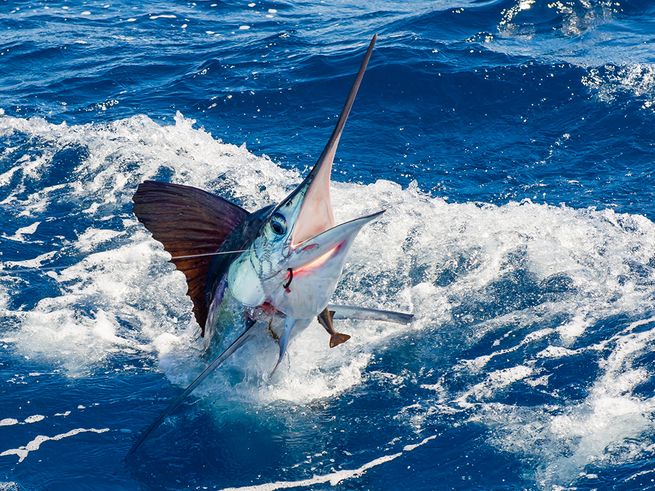
2 of 5
White marlin are the second most common marlin species in Bermuda, but they don’t get much publicity. Why is that?
Whites, Kajikia albida, are a popular sportfish throughout the Atlantic, especially in places like Portugal, the Dominican Republic, Venezuela and the US mid-Atlantic coast. In 2017’s White Marlin Open fishing tournament, the top two fish that were weighed won their respective fishing teams more than $1.5 million each.
“Heck no, no one is ashamed to catch whites,” says Capt. Mike Kennedy of El Cazador, an 85-foot Scarborough. “They count as points too in Bermuda tournaments. We’re here most of June to August, and during that time, we just see higher numbers of blue marlin than whites, although the whites tend to be good size.”
Having listened to radio chatter over the years, Bermuda Triple Crown tournament director Dan Jacobs remarked, “Many times over, captains say the whites they just released would sure be nice to have in the White Marlin Open because of their size. We see lots of big whites in Bermuda, and usually a few round-scale spearfish, and even shortbill or long-bill spearfish.”
Throughout the three tournaments in the 2017 Bermuda Triple Crown series, 126 blue marlin were caught compared to 70 white marlin. In 2016, 161 blue marlin and 20 white marlin were recorded.
“Everyone comes to Bermuda to catch that one,” says Capt. Danny Hearn of Blank Check, a 64-foot Bayliss. “That’s why the whites aren’t as popular. Boats are heading over to Bermuda for that grander. Plus, some of the U.S. boats come from areas with even higher concentrations of white marlin than Bermuda. Personally, I’m happy to have any flag flying when coming back to the docks.”
July marlin tournaments incentivize anglers to target big blues based on the payouts. For Bermuda Triple Crown tournaments, anglers earn 500 points for every blue marlin officially released, or one point per pound for every blue marlin weighed and verified over the 500-pound minimum. Tournaments also award cash and prizes to teams that catch the largest blue marlin by weight.
The World Cup Blue Marlin Championship, held on July 4, offers a hefty payout for the single largest blue marlin caught anywhere across the world. Day one fishing of the Bermuda Billfish Blast also occurs on July 4, 2018. At least on that day, blue marlin will get all the attention from Bermuda fishing teams signed up for both tournaments.
One giant blue-marlin catch can make an entire season — just ask Capt. Cragin “Curly” Curtis and angler Stephanie Choate. In 2016, Choate chartered Curtis’ Reel Addiction, a 48-foot Billy Holden, to fish the Bermuda Triple Crown series. On day one of the Bermuda Billfish Blast, Choate landed a 625-pound blue marlin after an hour-and-20-minute fight. Two more strong days of fishing on the Reel Addiction in the Blast allowed Curtis and crew to capture the win. The 625-pounder also won the World Cup Big Blue Challenge Optional Jackpot for a collective $400,000 payday. Curtis and Choate went on to win the entire 2016 Bermuda Triple Crown.
The Right Time and Place
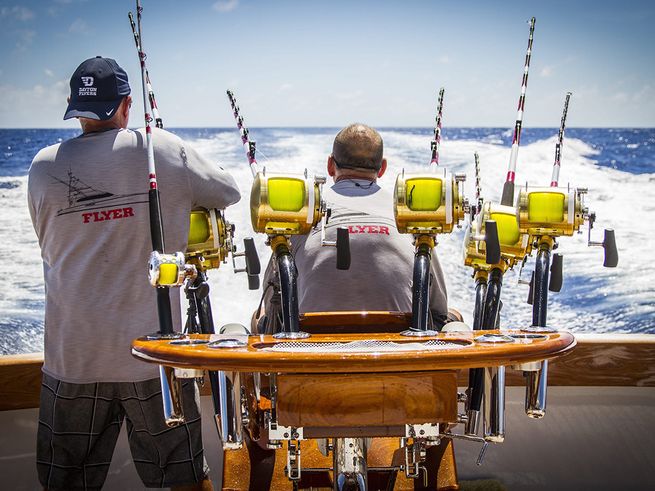
3 of 5
“White marlin show in Bermuda in the early summer and depart in the early fall, likely because of available prey, and possibly for spawning,” says Struan R. Smith, Ph.D., of Bermuda’s Department of Environment and Natural Resources. “We don’t believe they stay here all year, as our water temperatures are too cold for them in the winter.”
General tagging studies show that white marlin pass Bermuda in their seasonal migrations, something local charter boats and tournament anglers have experienced for years. Heading south or west from Bermuda, whites winter in the eastern Caribbean and the waters off northern South America, although no tagging studies have specifically looked at the movement of Bermuda white marlin departing the island’s waters, says Smith.
Earlier in the year, March to July water temperatures can be great for white marlin, says Curtis.
“Water temps are in the 70s, and that’s when white-marlin fishing can even be better than blue-marlin fishing,” he says. “I’ve noticed blue marlin prefer 80s water temperatures, while the whites prefer the 70s. July is the last hurrah for whites in Bermuda — you might not see as many white-marlin catches in the Sea Horse Anglers Tournament held at the end of July.”
Curtis sees higher numbers of white marlin when fishing for wahoo in the spring compared to the summer months. Curtis also detailed a unique chumming technique he used to target tuna and wahoo, but that’s a different article for another day.
“When targeting wahoo in the spring, we use rigged ballyhoo paired with Carolina-style sea witches that we tie ourselves,” says Curtis. “We’ll troll at 5- to 6-knot speeds, and the whites and wahoo will hit them at that time of year. Even then, white marlin are mostly secondary catches.”
White and blue marlin mingle in Bermuda waters for the majority of summer, allowing tournament fishing teams to target both species.
“I truly believe the white marlin follow the same upwellings and target the same baits as blue marlin,” says Kennedy. “Those currents and winds push toward the banks, creating eddies off the seamounts. It attracts the tunas, wahoo and marlin all in the same areas.”
Kennedy searches out upwellings more than specific temperatures. “I’d rather find those areas with high nutrients than fish a specific temperature,” he says. “It’s only a 25-mile run to the far end of Argus Bank. At the end of the day, most of the Bermuda boats are fishing the same waters. You know certain boats will be at certain spots. We’ve had success at Argus Bank, but there’s also the popular Challenger Bank that holds plenty of fish.”
Hearn prefers to look for temperature disparities. “Temperature breaks are a great area to target white marlin,” he says. “Fish both sides of the break and look for the baitfish. We are not afraid to fish in green water and shallower waters on top of the banks to find fish.”
No matter where tournament anglers head out for the day, they usually don’t have to travel far to the fishing grounds, especially compared to other big-game fishing destinations around the world.
“We are a tiny pinprick in the ocean,” says Curtis. “The price of fuel in Bermuda limits our runs each day. We rely on the currents to bring us the fish.”
Massage Your Spread for Whites
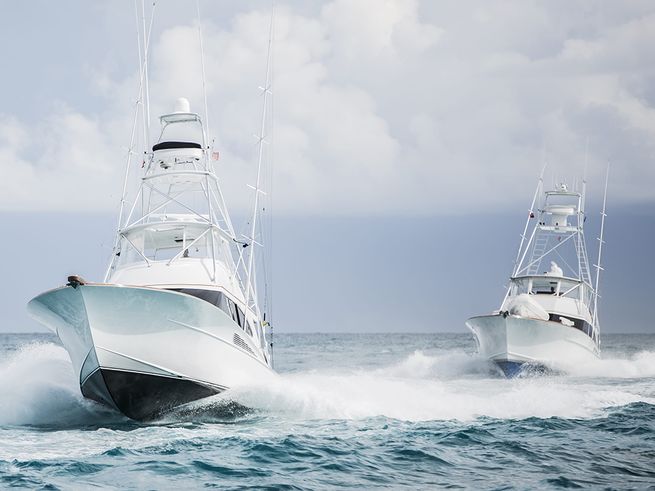
4 of 5
“Locals call white marlin ‘seaweed,’” says Curtis, “but their points really matter in tournaments. I’ve seen private boats come to Bermuda and win, partly because a well-oiled fishing team can rack up points on white-marlin catches. I’ve definitely taken notice.”
Blue-marlin tackle is overkill for white marlin, but that big blue marlin, and even numbers of blue marlin, is what fishing teams really want, says Hearn.
“We’re apprehensive to downsize tackle for whites, because you know as soon as you do that big blue will hit your lightest rod.”
Although whites hit blue-marlin lures, blue-marlin tackle is not ideal for the lesser white marlin.
“Usually, you get one shot at white marlin [with blue-marlin tackle],” says Curtis. “If they feel the sting of the hook, they’re gone. A blue marlin might eat a lure 10 times.”
Fishing teams in Bermuda must make a choice — keep their traditional trolling spreads of six big-bodied lures or start incorporating a lighter setup that’s meant for whites. Another option: Have some pitch baits ready to present to the white marlin that flashes in the spread.
“In the past, some teams might put out a couple smaller lures, but no one wanted to downsize too much, staying with the heavier 300-pound leaders,” says Curtis. “Using pitch baits with lighter tackle is a better option.”
If specifically targeting whites, Curtis would rig smaller ballyhoo to some 50s. “That’s not a bad option for whites, trolling at 5 to 6 knots,” he says. “And you don’t need teasers. The year we won the Bermuda Triple Crown, we didn’t use a single teaser. I get some weird looks when I tell people that.”
But Curtis almost never specifically targets whites, so his normal spread is six rods — five 130s and one 80-wide. He prefers purple-and-white lures. The lone 80 is for wahoo, white marlin, mahi-mahi and tuna.
“To maximize my opportunities with white marlin, I would try to get ballyhoo back to them on a 30-wide,” says Hearn. “Last year, we had baits ready for the whites. Instead of strictly lure fishing, as is common in Bermuda, we had baits like Spanish mackerel and horse ballyhoo in our spread. There’s really no second or third chances with white marlin unless using smaller dink baits.”
If Kennedy were strictly to target white marlin, he wouldn’t drop down below 50-pound tackle.
“I would pull natural baits behind Iland lures,” says Kennedy. “I would downscale to smaller Hawaiian Eyes and rig them with ballyhoo. I’d still use typical squid chains for teasers and keep the trolling speed about 8.5 knots.”
In Kennedy’s experience, whites tend to stay farther back from the stern, possibly because his crew runs their smaller lures in the longest positions. By contrast, blues will come right up to the teasers in the prop wash, he says.
“In my experiences from the bridge, I’ve had pesky whites come up and look at a bait, then another bait, then another bait,” says Kennedy. “Never hitting the bait, or at least never coming in contact with the hook. Blues tend to track just one bait. Sometimes turning and going back over an area can be productive, nmore so for blues than whites.”
What most fishing teams agree on is that if you want the best chance at whites in Bermuda, keep smaller natural baits ready to go. A pitch bait like a ballyhoo or Spanish mackerel is a perfect presentation. When trolling lures, the bite either happens or it doesn’t. Dropping back natural baits is not as clear-cut as lure fishing, so operator error can play a role. If you plan to go au naturel with a bait or two, make sure you brush up on your drop-back technique before that tournament-winning white marlin pops up in your spread.
All-In On White Marlin
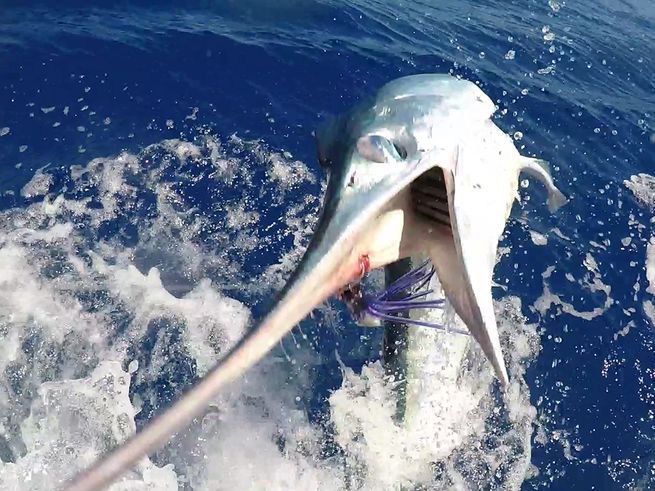
5 of 5
To nail down a rig specifically for white marlin, I reached out to experienced Virginia Beach angler Ken Neill of Healthy Grin Sport Fishing. Lying in the zone between North Carolina and New Jersey, Virginia is right in a sweet spot for white-marlin fishing from July to September.
Gear
Neill prefers 20- to 30-pound-class tackle, rigged with 30-pound monofilament main line and 100-pound mono leader. Many anglers will go even lighter on the leader, but blue marlin are around Virginia waters, and much of Neill’s white-marlin fishing is tied to research that requires billing the fish for pop-up tag placement and genetic sampling.
Presentation
Neill utilizes mostly small, naked ballyhoo rigged on a 7/0 circle hook rigged to swim, as opposed to skipping. He also does some live-baiting with tinker mackerel caught on-site. He catches them on mackerel rigs, bridles them to a circle hook (up to 8/0 size) and starts trolling. He runs a squid daisy chain off each rigger and deploys at least one dredge, often two depending on conditions. For whites, troll speed is about 6 knots with ballyhoo, only 2 knots when live-baiting.
Water Temperatures
Neill has caught white marlin in dirty water in temperatures from the low 60s to mid-80s, but he prefers clear water in the mid-to-upper 70s. He uses recent temperature maps to find where the temperature breaks are offshore. Then he uses radar to find birds. A temperature gauge allows him to stay on the warm or cool side of a break, and he’s not afraid to try both sides. A bottom machine should mark the bait — when you find the bait, stay with it.
